Did you know Philodendrons could reach 10 feet in their wild homes? These vibrant plants often outgrow their pots. Moving your Philodendron to a larger pot with fresh soil is vital. It stops it from feeling squeezed and helps it grow well. By re-potting, you keep your Philodendron both happy and healthy.
Looking after a Philodendron means ensuring ample growth space. This is especially true for fast-growing Philodendrons. A growing Philodendron requires more food and water to stay strong. A plant too big for its pot will face obstacles like wilted leaves. By transferring it to a larger pot, you give it a new home. This process, called repotting, not only provides more room. It also introduces fresh soil, boosting new foliage growth.
Key Takeaways
-
Philodendrons need regular repotting to prevent root-bound issues and encourage healthy growth.
-
Repotting provides fresh, nutrient-rich soil to support your philodendron’s needs.
-
Proper philodendron pot size and philodendron soil mix are crucial for your plant’s well-being.
-
Timing your philodendron repotting during the active growing season is best for a successful transplant.
-
Regularly maintaining your Philodendron’s root health and philodendron nutrients is key to its long-term thriving.
Why Repotting Your Philodendron is Important
Philodendrons can outgrow their pots because they adapt to small spaces. When you see the philodendron roots coming out of the pot’s bottom or holes, it’s time to transplant. Doing this will let your plant’s philodendron roots stretch out. It stops them from becoming philodendron root-bound.
The philodendron potting soil can lose its nutrients as time passes. Repotting will give your plant fresh soil rich in nutrients. With a bigger pot and new soil, your Philodendron will have more room to grow. Expect to see more philodendron foliage and a healthier philodendron plant.
Preventing Root Bound
If a Philodendron becomes root-bound, it might stop growing. It could show signs of philodendron stress and philodendron transplant shock. By moving it to a bigger pot, the philodendron roots can grow freely.
Refreshing the Soil
Philodendrons use up the soil’s nutrients as they grow. Repotting with fresh soil can prevent philodendron root rot. It can also boost philodendron root development.
Promoting Healthy Growth
With a new, larger pot and fresh soil, your Philodendron will have more space to grow. It can become bigger, healthier, and stronger. You’ll enjoy a plant with lots of philodendron leaves and philodendron foliage, making your space lush and vibrant.
Signs: It’s Time to Repot Your Philodendron
Watch your Philodendron carefully as it grows. Look for signs it needs a bigger pot. This includes checking its roots, how fast it’s growing, and the best times to repot it. By doing this, you’re making sure your plant gets all the care it needs.
Roots Outgrowing the Pot
If you see roots coming out of the bottom of the pot, or circling inside, it’s time to repot. Your Philodendron might be root-bound. It needs a bigger pot and fresh, well-draining potting mix for its growth.
Slow Growth
Has your Philodendron’s growth slowed down? Or are its leaves not as big and green as before? This could mean it’s not getting enough nutrients and water from the soil. A bigger pot with rich potting mix can help it grow healthy and green again.
Ideal Repotting Season
The perfect time to repot your Philodendron is during its spring or summer growth. Plants do better with the change then. Repotting in winter can be tough on them and cause issues like root rot.
Keep a close watch on your Philodendron’s roots and its growth. Also, remember the best times to repot it. This way, your plant will thrive and appreciate its new, bigger pot.
Preparing for Repotting
Repotting your Philodendron is easy with the right tools. You don’t need fancy things but the right tools help a lot.
Start with a new pot, 1-2 inches bigger. It must have holes at the bottom for drainage. You’ll also need philodendron potting mix, a watering can, and scissors.
Choosing the Right Pot
The new pot should only be slightly bigger. This lets your Philodendron grow but not be overwhelmed. It’s key that the pot drains well to keep your plant healthy.
Preparing a Well-Draining Potting Mix
Mixing potting soil with perlite or bark creates good philodendron potting soil. Add organic matter like compost. This mix gives your Philodendron the light, humidity, and temperature it loves.
how to replant philodendron
First, water the Philodendron well the day before repotting. This makes it easier to remove and reduces plant stress. Loosen the soil around the pot’s edge. Gently take out the plant and check the roots.
Trim any soft or diseased roots. Make four cuts from the top to the bottom of the root ball. Tease out some roots for philodendron propagation and new growth. Next, put the Philodendron in its new pot. Start with an inch of fresh soil at the bottom.
Add more soil around the plant. Press the soil down gently to remove air pockets. Water the plant’s soil well. This helps the plant settle in its new home.
For the best philodendron root division, keep an eye on the plant’s water and philodendron fertilizer levels. With the right care and philodendron climbing support, your Philodendron can do well in its new home. It will grow and show off the lovely philodendron varieties you love.
Post-Repotting Care
After repotting your Philodendron, giving it proper care is crucial. It will help it grow well in its new home. Here are important care tips to consider.
Lighting Requirements
Put your Philodendron where it gets indirect sunlight. It does well in bright, filtered light. Yet, it can manage in lower light. Keep it away from direct sun, which can harm the leaves. Right lighting helps in philodendron propagation and other growth.
Watering Needs
Wait for the soil’s top inch to dry before adding more water. Too much water can cause root rot. Be careful with how often you water your plant. In the growing season, you can try the water propagation method. This means putting the roots in water for new growth.
Fertilizing Schedule
Fertilize your plant every 4-6 weeks during the growing time. Use diluted liquid fertilizer that’s balanced. This feeds your Philodendron and helps it grow strong in its new soil.
Pruning and Maintenance
Prune yellow or brown leaves often. This helps your plant stay healthy and look good. Also, clean the leaves to keep them free from dust. This makes it easier for the plant to make food.
By sticking to these care steps after repotting, your Philodendron will have a great beginning in its new spot. This will support its growth, like philodendron propagation. You’ll soon have a beautiful, healthy plant.
Troubleshooting Common Issues
Your Philodendron could face some challenges. Understanding and solving these issues helps it stay healthy.
Overwatering and Root Rot
Too much water can make roots soft and mushy, leading to root rot. If you see this happening, pull the philodendron from its pot. Cut off the bad roots and put it in new, well-draining soil. This will stop the problem from getting worse.
Underwatering and Wilting
If your philodendron doesn’t get enough water, its leaves will wilt. To prevent this, water your plant as soon as the top soil dries out.
Pests and Diseases
Spider mites, mealybugs, and scale insects are some common philodendron pests. Use insecticidal soap or neem oil to get rid of them. Now, philodendron diseases like leaf spots and root rot can happen too. Check your plant often and fix problems quickly. This helps it grow healthy both inside and outside.
Learning these philodendron troubleshooting tips will help your plant grow well. Enjoy its beautiful, full leaves for many years.
Conclusion
Repotting your Philodendron is key for its wellness. It avoids root-bound troubles, refreshes soil, and supports growth. I can repot it well by choosing the correct pot size and mixing good-draining soil. Taking care after repotting, like watering and pruning, is very important.
By using the right methods, my philodendron will be lively and beautiful. I now know how to handle potting mix, drainage holes, root rot, and root-bound problems. My plant will do well with proper soil, roots, water, light, fertilizer, pruning, and climbing support.
Keeping an eye out for pests and watching the foliage is crucial. It helps in smooth transplanting and prevents transplant shock. With this knowledge, I’m sure my Philodendron will flourish in my home or garden for years.
<div class="quiz-container">
<h1> How to Replant a Philodendron: A Step-by-Step Guide </h1>
<form id="philodendron-replant-quiz">
<div class="question">
<h2>1. When is the best time to replant a philodendron?</h2>
<label>
<input type="radio" name="q1" value="a"> Winter ❄️
</label>
<label>
<input type="radio" name="q1" value="b"> Spring
</label>
<label>
<input type="radio" name="q1" value="c"> Summer ☀️
</label>
<label>
<input type="radio" name="q1" value="d"> Fall
</label>
</div>
<div class="question">
<h2>2. What is the first step in replanting a philodendron?</h2>
<label>
<input type="radio" name="q2" value="a"> Watering the plant thoroughly
</label>
<label>
<input type="radio" name="q2" value="b"> Removing the plant from its old pot
</label>
<label>
<input type="radio" name="q2" value="c"> Preparing the new pot with soil
</label>
<label>
<input type="radio" name="q2" value="d"> Pruning the roots ✂️
</label>
</div>
<div class="question">
<h2>3. How should you handle the roots when replanting?</h2>
<label>
<input type="radio" name="q3" value="a"> Prune all the roots ✂️
</label>
<label>
<input type="radio" name="q3" value="b"> Gently loosen the roots
</label>
<label>
<input type="radio" name="q3" value="c"> Wash the roots with soap
</label>
<label>
<input type="radio" name="q3" value="d"> Cut the roots in half ✂️
</label>
</div>
<div class="question">
<h2>4. What type of soil is best for replanting philodendrons?</h2>
<label>
<input type="radio" name="q4" value="a"> Sandy soil ️
</label>
<label>
<input type="radio" name="q4" value="b"> Clay soil
</label>
<label>
<input type="radio" name="q4" value="c"> Well-draining, rich soil
</label>
<label>
<input type="radio" name="q4" value="d"> Rocky soil
</label>
</div>
<div class="question">
<h2>5. How often should you water the philodendron after replanting?</h2>
<label>
<input type="radio" name="q5" value="a"> Daily
</label>
<label>
<input type="radio" name="q5" value="b"> Once a week
</label>
<label>
<input type="radio" name="q5" value="c"> When the top inch of soil is dry
</label>
<label>
<input type="radio" name="q5" value="d"> Once a month ️
</label>
</div>
<button type="button" onclick="checkAnswers()">Submit</button>
</form>
<div id="results"></div>
</div>
<style>
.quiz-container {
font-family: Arial, sans-serif;
max-width: 600px;
margin: auto;
padding: 20px;
border: 2px solid #4CAF50;
border-radius: 10px;
background-color: #f9f9f9;
}
h1 {
text-align: center;
color: #4CAF50;
}
.question {
margin-bottom: 20px;
}
label {
display: block;
margin: 5px 0;
}
button {
display: block;
width: 100%;
padding: 10px;
background-color: #4CAF50;
color: white;
border: none;
border-radius: 5px;
cursor: pointer;
}
button:hover {
background-color: #45a049;
}
#results {
margin-top: 20px;
text-align: center;
}
</style>
<script>
function checkAnswers() {
const answers = {
q1: 'b',
q2: 'a',
q3: 'b',
q4: 'c',
q5: 'c'
};
let score = 0;
const form = document.getElementById('philodendron-replant-quiz');
const results = document.getElementById('results');
const formData = new FormData(form);
formData.forEach((value, key) => {
if (value === answers[key]) {
score++;
}
});
results.innerHTML = `<h2>Your Score: ${score}/5</h2>`;
if (score === 5) {
results.innerHTML += `<p> Excellent! You are a Philodendron replanting expert! </p>`;
} else if (score >= 3) {
results.innerHTML += `<p> Good job! Keep up the great work in caring for your plants! </p>`;
} else {
results.innerHTML += `<p> Keep learning and your Philodendrons will thrive! </p>`;
}
}
</script>
How to Replant a Philodendron: A Step-by-Step Guide
Source Links
how-to-replant-philodendron


